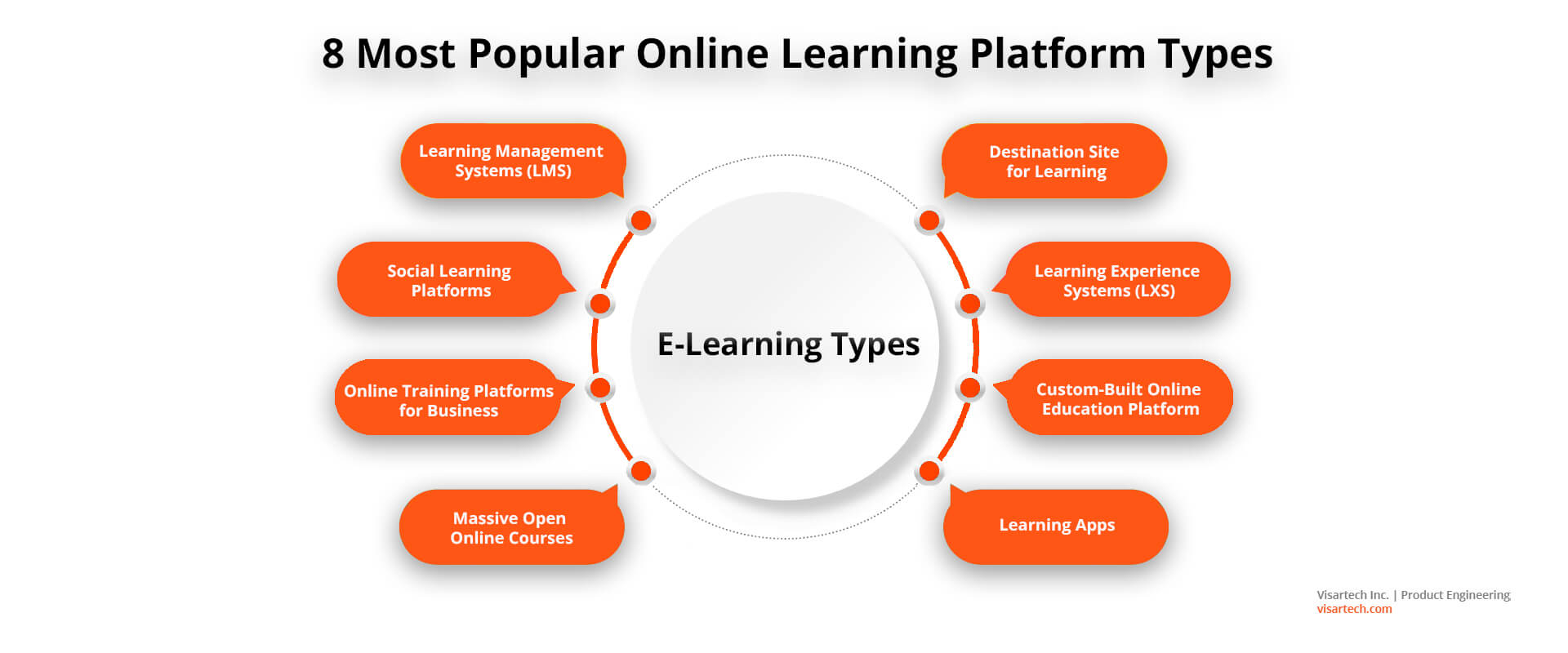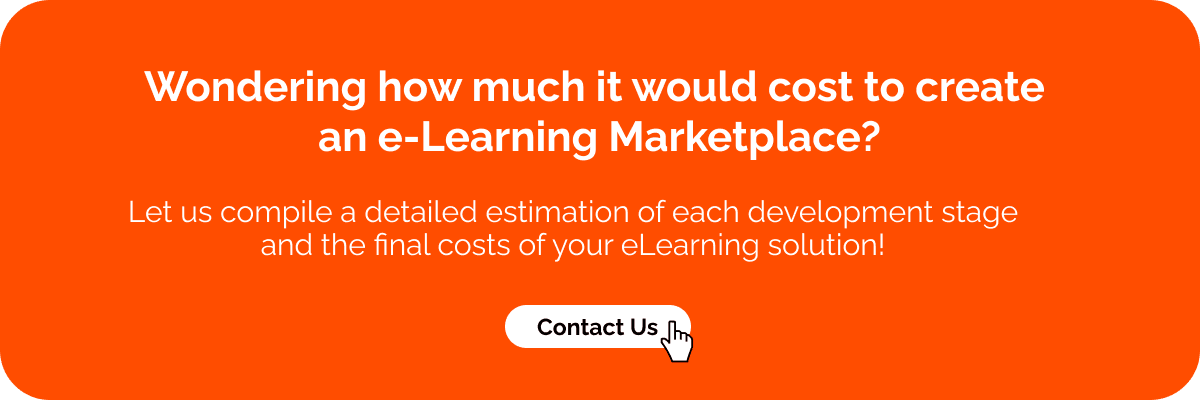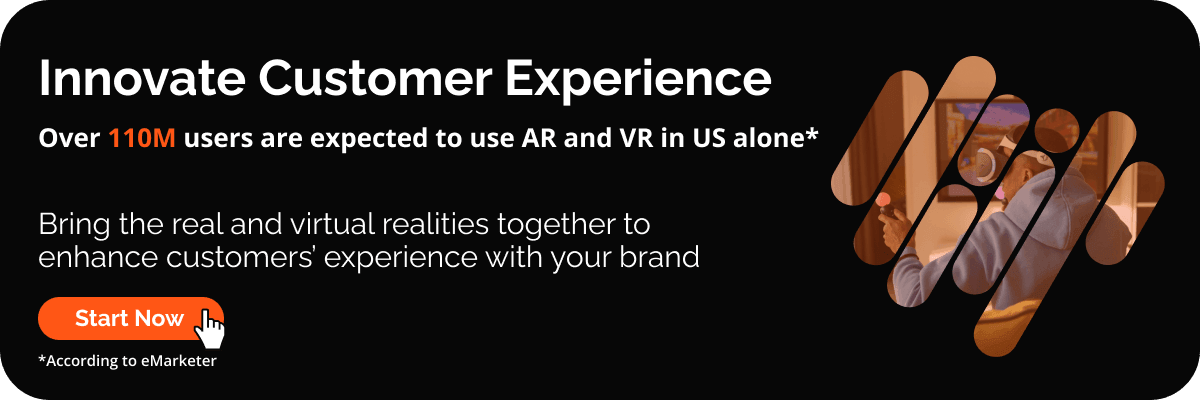The e-learning market is booming – in less than 3 years it has expanded by 200%. However, as the competition gets tougher, organizations specializing in e-learning platform development, are looking for new opportunities for business growth.
In this blog post, we are going to uncover all the details about corporate elearning and educational marketplaces for those who are looking to create new e-learning solutions and the ones interested in advancing the existing educational platforms to thrive in the e-learning market.
What Makes eLearning Marketplaces Look For the “Blue Ocean”
eLearning solutions development is now a broad concept covering creating LMS, e-learning app development, and building corporate online learning platforms. In general, organizations tend to compete on a relatively narrow range of factors such as:
- pricing;
- content;
- the credibility and reputation of authors or featured speakers.
This sparks desperate competition with every company trying to bite off their market share, acting like sharks in turbulent waters, and creating a “red ocean”, filled with blood. Needless to say, such waters are neither friendly nor welcoming.
The “blue ocean” strategy, described in the iconic bestseller by W. Chan Kim and Renée A. Mauborgne, offers an alternative approach. Organizations adhering to this strategy seek to differentiate their products from competitors to the point when the difference creates unique market value and renders competition irrelevant.
The e-learning market may feel like a red ocean, with companies selling universal products like knowledge and skills. However, this is only true for organizations that lack a well-formulated blue-ocean growth strategy.
In the next sections, we will make a brief overview of the current e-learning industry landscape, list its key players and top features of e-learning marketplaces. We will also offer actionable strategies for taking your e-learning marketplace to the next level by leveraging modern leading-edge tech.
Reasons Why B2B And B2C Markets Should Adopt eLearning Solutions
They say an average shelf-life of a particular skill rarely extends beyond 2 years in a post-industrial era. Lifelong education is no longer an option, it is a necessity, dictated by the ongoing technological advancements. In this regard, learning technology tools have already become an invaluable asset for learners in both the corporate sector and academia.
Benefits of E-learning Adoption in Academia
The adoption of e-learning solutions has gradually been taking place in academia, but the covid-19 pandemic has given it an unexpected boost. Despite the numerous obstacles and issues with connectivity, schools were forced to adapt to the new normal and embrace online and hybrid learning.
The obvious benefits of e-learning solutions:
- safety training procedures;
- gamification to increase engagement levels;
- the ability to cover all groups of learners, including physically impaired students who cannot attend;
- better knowledge and skills assessment;
- programs tailored to learners’ needs;
- progress assessment and reporting;
- the option to track students’ behavior patterns.
An end-to-end LMS, for example, may also help educators handle administrative tasks and help with managing staff, assets, and budgeting.
E-Learning in the Corporate Segment
The corporate segment is adopting e-learning for employee training to boost skills. Companies are highly interested in developing knowledge bases, building in-house expertise, and increasing employee motivation and retention. The demand for e-learning is especially high in industries like healthcare, IT, telecommunications, retail, and finance.
The advantages of e-learning for businesses include:
- reducing corporate education expenses;
- boosting engagement levels;
- using various content formats;
- generating revenue by selling courses to external parties;
- using online training platforms for fostering and expanding proficiency and expertise.
In recent years, educational marketplaces like Coursera, Udemy, and Edx have gained immense popularity both with casual learners enrolling in courses for personal development and working professionals willing to acquire new job skills. E-learning offers them advantages like:
- the comfort of following their own learning speed;
- privacy of students’ progress;
- a wide array of content formats they can adjust to their needs.
In the B2C market, educators can create a nearly unlimited outreach and target audiences in all geographic locations using digital e-learning solutions. Needless to say, it is a lucrative business niche that many aspiring entrepreneurs want to use to their advantage.
8 Different Types of eLearning Platforms
There are several distinct online learning platforms types that you should know about if you’re thinking of e-learning app development or LMS development. Below is a list of the most widespread types of e-learning platforms.

#1. Learning Management Systems (LMS)
Most of the learning management systems are web-based and have all the features necessary for creating online courses, as well as knowledge assessment tools. LMS acts as a corporate e-learning solution, or an online learning platform for schools and colleges.
#2. Social Learning Platforms
Humans learn best in social situations where they can mingle and talk. A social learning platform is, essentially, LMS with social network features encouraging people to interact and share what they’ve learned. Such an interactive application with courses boasts higher completion and satisfaction rates because people are enjoying peer feedback and group dynamics.
#3. Online Training Platforms for Business
E-learning platforms for businesses usually focus on evaluating the knowledge and skills of job prospects and company workers. These platforms help organizations ensure that the skills and expertise of workers are on the proper level. The programs may be adjusted to the needs and pace of each learner.
#4. Massive Open Online Courses
MOOCs are e-learning websites containing courses that may be available on a free and paid basis. The price will be dictated by the type of certificate learners will receive after they complete the course. Normally, there are no time restrictions, so users can combine courses with their day jobs.
#5. Destination Site for Learning
Big online course repositories, containing classes on various subjects from different providers and using a wide array of payment and access models, like Coursera and Udemy. These websites usually offer course authoring tools, helping instructors build and manage their own courses. Learners get to access course content in different formats and participate in forums and discussion groups.
#6. Learning Experience Systems (LXS)
LXS focuses on personalized immersive education. Built to eliminate the shortcomings of traditional LMS, which are designed to address the needs of an academic program or business owners, these systems deliver user-focused, intuitive learning and interactive experience. LXS features a variety of formats, authoring tools, and has social learning features.
#7. Custom-Built Online Education Platform
Designed to meet the unique needs of a particular business or an educational establishment, such platforms require custom software development. App development cost of such an e-learning solution might be more expensive than using online course authoring tools. However, you get exactly what you want, and have full control over what you want people to learn via your platform.
Read more: How to Save Money on a Web Project for Businesses
Learn how to select the best tech stack for your web application
#8. Learning Apps
The speed of life is accelerating, and microlearning, enabling people to learn in small chunks whenever they have time, is gaining momentum. Interactive educational software like Duolingo, or more specific game genres like learn-to-read gamified apps or word game apps help people learn much faster and with greater quality. Essentially, learning through educational games and quests may be a perfect idea if you’re considering e-learning app development.
What Makes E-Learning Platforms so Popular?
The digital education segment is rapidly expanding and its value is anticipated to reach $257.7 billion by 2028. To a large extent, the staggering growth rate may be attributed to quarantine limitations.
Yet, there are many advantages of e-learning platforms for learners:
- the courses are usually available from any location, so geographical limitations are no longer an issue;
- users can easily enroll in programs after they register on a platform;
- best online training platforms offer a choice of course formats;
- the course is usually available in a variety of content formats: audio, video, text, or printable pdf;
- e-learning gamification makes courses fun and engaging;
- users may take tests from any location;
- tracking one’s progress is easy using AI tools and big data;
- online courses are usually cheaper than individual learning.
The benefits of online learning platforms for educators and trainers are as follows:
- a set of handy tools makes course creation easy as a breeze;
- it’s easy to upload, store and manage content;
- broad outreach and built-in interactivity make teaching feel more rewarding;
- increased efficiency: trainers can reach thousands of people at the same time;
- analytic tools bring insights into learners’ knowledge gaps, progress, and behavior.
As you can see, e-learning marketplaces have a lot to offer in terms of features and user experience. This also implies that the popularity of educational platforms will continue to increase in years to come, along with the customers’ demands and expectations. The solution lies not only in adding new features but also in revolutionizing existing business models.
In the next section, we will explore the must-have features of e-learning marketplaces.
10 Must-Have Features of Educational Marketplaces
A successful learning management platform offers learners and educators unique value. Yet, there are some mandatory features that users now expect from learning marketplaces.

- Registration/Login
Best online training platforms have easy registration and account access. The fastest way to enable it is by using their social media accounts such as Facebook, Twitter, and LinkedIn.
- User profiles
Platform users should be able to set up their profiles. Depending on their roles (student, teacher, trainer) the platform should request different personal information and user details.
- Search
The marketplace should enable users to search for different courses based on the topic, duration, authorship, testimonials, and difficulty level.
- Course pages
Each course should have a proprietary page containing the basic information about the course program, schedule, duration, price, instructors, and their qualifications. Course authors should also be able to add introductory videos, and students should be able to submit their feedback about the course.
- Course creation capabilities
How to create an e-learning course should not be a problem for educators you partner with. The platforms should automatically enable instructors to create a course structure, add tests for knowledge assessment as well as text and multimedia content.
- Integrations with payment systems
Learners should be able to pay for tuition in a variety of ways including credit cards and online payment systems. Obviously, all the payment providers you partner with should use secure payment verification methods.
- Built-in analytics modules
Data analytics modules are powerful tools enabling trainers to assess the progress of students and their participation and involvement rates, gain useful insights about how they can improve their programs. Enhanced data visualization tools and instant access to analytics increase teachers’ satisfaction with their experience on the platform.
- Notifications, and update alerts
Users should be able to receive news about the new courses or the updates added to existing ones. Updates and alerts should be available via e-mails, social media messages, SMS and be easily accessible via smartphones.
- Multilanguage support
Access anytime from anywhere is what users love most about online learning platforms. If you want to build a successful e-learning platform, make sure to offer courses in different languages for learners across the world.
- Admin panel
An admin panel should offer an administrator a holistic view of the platform, including user profiles. The administrator should be able to verify courses, add and remove users, switch their subscription plans, and eliminate issues if they arise.
Users also expect an educational platform to have non-functional characteristics like:
- excellent usability and UI;
- compatibility with various operating systems, devices, and platforms;
- non-disruptive performance that ensures quick and seamless access.
Best 10 Online Course Marketplaces
Finally, let’s make a brief overview of the top e-learning marketplaces, their pros, cons, and tech stacks.

#1. Udemy
Udemy courses have been leveraged by over 57 million users. This e-learning marketplace has the best credentials for creating, launching, and marketing your first course. The platform will virtually guide teachers through all the aspects of course creation, to the point when they can submit videos for reviews and get advice on how to hone them to perfection.
From the learner’s standpoint, Udemy has affordable prices and a wide range of topics. However, the platform’s certificates are not accredited, which means learners can’t put them on their resumes to impress talent recruiters.
Udemy generates income from charging instructors a percentage from every course they sell, as well as from user subscriptions.
The core web development tech stack of Udemy includes Node.js, MySQL, NGINX, Python, and Django. The platform is built using AWS cloud services such as AWS Lambda, Amazon S3, and Amazon EC2.
#2. Coursera
Speaking of educational platforms examples, we can’t help but mention Coursera. With the number of users reaching 118 million and over 7000 courses available on a platform, this marketplace is one of the top destinations for online learning.
One of Coursera’s advantages is its partnerships with educational institutions, which allow students to attend online classes at renowned colleges and universities. Coursera also offers certified courses from leading companies like IBM, Cisco, and Intel.
The courses are affordable, however, getting a degree will require significantly higher costs. The platform’s business model involves selling courses and tuition to learners. Learners pay fees to enroll in learning activities and get certified by Coursera.
Coursera’s main programming languages are Scala and Python. Its core tech stack includes MySQL and Backbone.js for the frontend.
#3. Udacity
Udacity has about 16 million users and is the best e-learning platform for learning hands-on business and technology skills. Its self-proclaimed specialty is upskilling and acquiring practical knowledge. A typical Udacity course is tailored to working professionals who have little time for learning outside their day jobs.
Practical orientation as well as the collaboration with major tech firms and international organizations is one of the platform’s main advantages. On the downside, Udacity courses are notoriously expensive (about $399 per month), additionally, the platform doesn’t offer any official degree or accreditation.
Still, it offers excellent tech and business courses for learners who want to advance their careers. Some of the courses are entry-level. Udacity makes money by selling courses to individuals and enterprises.
Udacity’s core technology stack includes React for a web frontend, Python and Scala, Bootstrap, GraphQL, JavaScript.
#4. EdX
For learners, who need official, accredited e-learning programs from major educational institutions, then EdX is the way to go. EdX is a credible platform with over 81 million users, partnered with 160 universities and colleges, and featuring over 3000 courses and 300 education programs.
One of the most compelling features of EdX is that users can take most of the classes free of charge. They can’t complete assignments and get certified, but they get an almost complete preview of the course content. On the downside, some users say EdX classes lack variety and are only suitable for those who have enough time for in-depth learning.
The platform makes money by charging educational institutions 30% of the course revenue they get using EdX.
EdX’s core tech stack consists of Node.js, React, PHP, Django, and Backbone.js for the frontend.
#5. Masterclass
The characteristic feature of the Masterclass platform that sets it apart from others are courses from celebrity authors and instructors. Masterclass is obviously the best choice for people who want to learn by positive examples of role models like Alicia Keys, Bobby Brown, and Gordon Ramsey. The platform’s videos are engaging and fun to watch.
Masterclass earns revenue by charging students monthly subscription fees for access to all of its classes. Alternatively, students may buy access to one of its classes for a smaller fee. The prices are very affordable, and learners may demand a refund in 30 days after they enroll in a course. On the downside, websites like Masterclass are surely not suitable for people looking for serious accredited education but are true treasure troves for casual learners.
Masterclass core tech stack includes React, Angular.js, and Rails.
#6. LinkedIn Learning
Created as a result of the LinkedIn merger with Lynda.com, LinkedIn Learning boasts an impressive amount of 700 million users. The courses focus on Business, Technology, and Creative professions, and are available on a monthly or yearly subscription basis. Users can learn at their own pace and rewatch the course anytime they feel like it.
LinkedIn Learning makes money by charging course fees. On the downside, there are no refunds, and the LinkedIn Learning courses aren’t accredited, so learners can’t put them on their resumes. However, they can share the certificate of completion with their LinkedIn network.
LinkedIn Learning’s core tech stack includes Amazon CloudFront, Apache Hadoop, Apache Kafka, Backbone.js, Couchbase, DigiCert, Jenkins, and Jetty.
#7. SkillShare
SkillShare is one of the top e-learning destinations for entrepreneurs and creative professionals. It’s also believed to be one of the best platforms for freelancers and small businesses. The platform features over 36,000 courses and has 12 million users. Skillshare has very affordable pricing, offers refunds, and, notably, scholarships for talented students. It also has plans for enterprises and teams.
The platform generates revenue using a combination of a freemium business model and advertising. Subscribed users enjoy unlimited access to content, including access from mobile devices and download capabilities.
Skillshare’s core tech stack includes React, Node.js, PHP, jQuery, NGINX, Cloudflare, Backbone.js.
#8. DataCamp
This platform for e-learning specializes exclusively in data science and analytics. Its courses are self-paced, and a lot of them are suitable for beginners. All in all, DataCamp is the best platform for people, planning a career change. The courses are built around microlearning principles and are practical and concise.
Data Camp focuses on niche-specific learning content and offers several subscription plans for individuals and enterprises.
The platform’s core tech stack consists of React, Node.js, JavaScript, Python, Ruby, R, Go, and uses Bootstrap for the frontend.
#9. Mindvalley
Mindvalley is another e-learning platform that stands out by covering users’ unique learning needs focusing on “what they don’t study in schools” – personal learning and development. The platform features courses on entrepreneurship, parenting, wellness, mindfulness, meditation, overcoming anxiety and stress.
Mindvalley offers courses for individuals and enterprises, and reaps revenue from subscriptions, live events, selling books and merchandise. It encourages learners to spread the word and invite more users to join their platform.
The platform’s core tech stack includes PHP, jQuery, NGINX, Slick, and Ubuntu.
#10. Ed2Go
Just like EdX, Ed2Go brings learners certified courses from renowned colleges and universities. This e-learning marketplace targets students, working professionals, and aspiring entrepreneurs. Ed2Go features a plethora of courses on business, finance, design, and technology.
The platform makes money directly from selling its courses to customers. At the beginning of 2022, its reputed revenue has reached $21 million.
Ed2Go’s core tech stack includes React, jQuery, Ruxit, Impact Radius, and Salesforce Web-to-Lead.
These marketplaces have already become household names, and include offerings for enterprises. As you can see, most of the marketplaces are trying to differentiate themselves from competitors by user groups, e-learning models, trainers, speakers, accreditation, conditions, and pricing.
In the next section, we will show you how the application of emerging technologies can give e-learning platforms a competitive edge.
6 Efficient Ways To Take Your eLearning Marketplace To The Next Level
As convenient as e-learning may be, there is still room for improvement. An online education website can stand out by offering users better learning experiences. Below is a list of technologies that you may use to make e-learning interactive and enjoyable.

Most importantly, even the top educational websites mentioned in the previous section could leverage new tech to add value to their services.
#1. Gamification
As the name suggests, gamification in learning involves using basic gameplay mechanics and dynamics in non-game settings. The concept has been known since 2010 but has fully evolved in recent years, finding wider application in domains like education, training, healthcare, finance, human resources, and social services.
The techniques may be as simple as giving out badges to successful learners that they can showcase on their social media, keeping scores of the top learners in their area, offering virtual gifts as an incentive to complete more assignments, and more. Encouraging competition, for example, can motivate learners to show better results.
At Visartech, we have built an e-learning app with gamification elements. The e-learning solution is aimed at maximizing internal staff engagement using bonuses that employees could get for their activities. The same approaches apply in e-learning, for example, in educational games.
#2. WebGL 3D Graphics
WebGL is a technology that applies programming methods to draw 3D graphics on a user’s computer screen. It is a fast and efficient way to visualize complex concepts and can be successfully applied in learning science, technology, and creative subjects.
WebGL is notably different from web graphics in the traditional sense: it uses code to create vivid and spectacular 3D experiences on the web. It also runs on users’ GPUs, which means smoother performance, lower latency, cross-platform availability, enhanced security, and, consequently, greater customer satisfaction.
Read more: Interactive 2D/3D Graphics for Web Projects
Discover WebGL capabilities your business can benefit from
At Visartech, we have used WebGL to build a virtual physics lab, helping students in American Universities undertake experiments that were previously possible only in real-life. However, the WebGL technology is also a perfect fit for web-based games, virtual tours, and any other fields requiring advanced visualizations.
#3. VR Collaboration Rooms
So far, the main disadvantage of e-learning is the lack of face-to-face interactions. People learn best when engaging in communication, and e-learning often falls short of a “human touch”. Yet, as VR technology becomes widely used in different industries, and the broadband Internet gets more accessible, immersive learning starts to become mainstream.
In recent years, we have witnessed the emergence of VR social networks, such as VR Chat and Rec Room. Facebook has recently unveiled its Horizon platform, where people can create “worlds” and interact in virtual environments. Spatial, the platform for VR conferencing, reported a stunning increase in use during the pandemic period. Clearly, the trend for extended reality technologies will see further development in the near future.
Virtual reality in e-learning is a true enabler of collaboration and group discussions. At Visartech we have built a collaborative platform allowing companies to hold meetings in virtual environments. Similar solutions are applicable in both corporate and academic e-learning. Thus the Visartech dedicated development team also created an e-learning platform for schools that enables students to take courses via VR classrooms.
Read more: An Interactive VR Whiteboard for Virtual Meetings
Find out how to create engaging virtual reality business meetings
#4. AR Experiences
The specifics of e-learning for business is the need to translate abstract concepts into practical usages in real work environments. In this regard, augmented reality can be an invaluable asset. The use of AR technology enables learners to receive instructions in real-time and instantly apply them at work.
Augmented reality is used to prepare learners for complex tasks by simulating real-life situations and environments. In sales, for example, AR can simulate difficult interactions with customers to train salespeople how to handle them.
Apart from efficient workplace training, the benefits of augmented reality in immersive education include accessibility of learning materials, the ability to learn in real-time, and maximized learners’ engagement.
At Visartech, we have built a geolocation app for gamified travel, which uses augmented reality as its core characteristic feature. The same principles can be applied in building e-learning games, apps, and services.
#5. Internal Social Network
Social learning is gaining momentum, and developing interactive education websites involves building a community of learners and educators. Forming a dedicated community around a particular brand always turns out to be a helpful tool to make its customers feel engaged and supported. Launching an internal social network could add an edge to your platform and act as an additional incentive for users to enroll in courses and share what they have learned.
A sports analytics application that we have built at Visartech, features an internal social platform where users can discuss their activity and share experiences.
#6. Learning Assistance Through Chatbots
The lack of face-to-face interactions often makes students feel confused about whom they can turn to if they have issues and problems. An interactive chatbot may help them find answers to their pressing questions and get help when they need assistance.
On top of that, chatbots are perfectly suitable for knowledge assessment, since they can check learner knowledge directly, in a conversational manner, and proceed with lectures tailored to fill knowledge gaps. Chatbots are also capable of providing learning content in a number of formats: videos, images, text, and audio files, and helping students handle tasks and assignments.
So far, the use of chatbots in education has been proved to lower churn rates and boost student satisfaction levels. Some chatbots are trained in helping students overcome emotional problems, for example, during onboarding on campus.
Final Thoughts
Efficient corporate elearning solutions prove to be truly sought after these days. However, to keep an e-learning platform successful and competitive, the key things should be always observed: constant updates, engaging content, interactive design, and a great tech foundation.
The trend toward e-learning is likely to persist in years to come, and education platforms are going to get increasingly more diverse and industry-specific. As the competition gets fierce, leveraging technologies to build interactive education websites with an entirely new level of user experience could truly make your platform unique. At Visartech we have all it takes to create a solution that will really stand out. With extensive expertise and the high-quality app development approach which implies continuous delivery of the product, we ensure the success of the production efforts.






